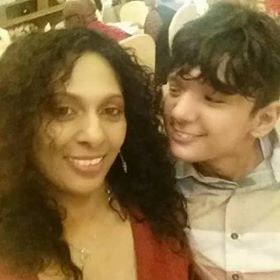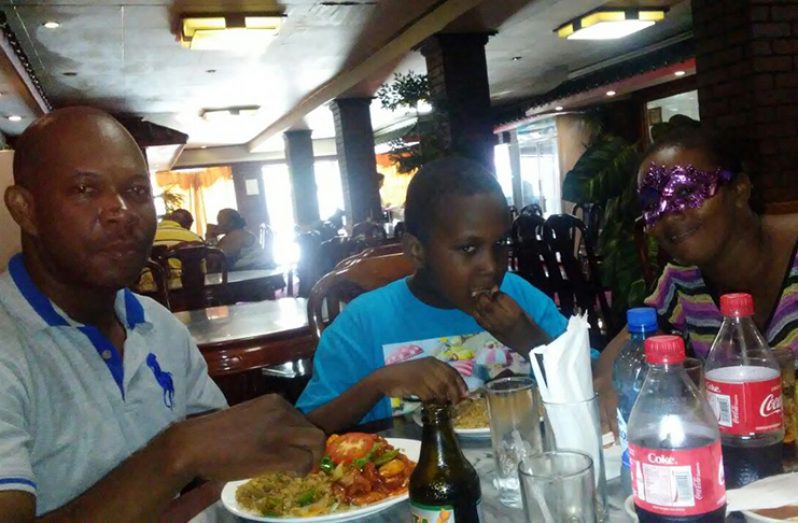By Gibron Rahim
– In observance of World Autism Awareness Day
MISCONCEPTIONS can be detrimental. This past Easter Monday, when many of us surely enjoyed kite flying and family picnics, was also coincidentally World Autism Awareness Day. Erroneous ideas and stigma surrounding autism spectrum disorders still persist in Guyana. Despite these and other challenges, parents of children with autism continue to ensure that their children are happy, healthy and able to live their best lives.
The Pepperpot Magazine spoke with a few parents to gain an understanding of the nature of parenting a child with autism.
LEARNING ABOUT AUTISM FOR THE FIRST TIME
One of these parents was Mark Dolphin whose son, Joel, started displaying signs of autism at an early age. The first sign was that, at almost two years old, Joel had still not spoken. Additionally, he would not make eye contact or play with anyone, including his siblings. The father explained that he and his family knew Joel’s hearing was fine since he would respond to sounds from the television. At the same time, he would not respond when his name was called.
Joel’s paediatrician, noting all the signs, suggested to his parents that he might have autism. Mark noted that he and his family did not know what the disorder was at the time. However, once they started to do research they realised that Joel displayed many of the signs and symptoms of autism including repetitive play, lack of eye contact and mimicking words and phrases. Finally having answers, Mark and his family wondered what to do next. “We found Step by Step,” he said referring to the Step by Step Foundation and its school, “and there is where our journey began and there’s where we are today.”
Routines are very important for children with autism. Wake up times and seating arrangements, for instance, are all set. Mark related though that getting Joel set for school is not difficult since he loves going. He spends his free time playing by himself or on his tablet. Mark explained that children with autism have a different concept of play though Joel does sometimes play with the other children at school. Everyday life poses challenges, sometimes, however – Joel sometimes has meltdowns and tasks like haircutting have to be done at home. He happily reported, though, that Joel is in the best of health with a hearty appetite. “He’s very energetic,” the father said.
MAKING ADJUSTMENTS
Since some aspects of life that we take for granted are not possible when a child has autism, Joel’s family has made appropriate adjustments. Mark related that he avoids public transportation as much as possible. “Certain things would trigger different responses,” he explained. These include stimuli such as loud noises and camera flashes. The public’s responses to children with autism are another aspect of concern. Mark noted that, while there is greater awareness now, the general population does not necessarily understand how different children along the autism spectrum can be. “What would affect one child would not affect the other child,” he said. He is grateful that he has colleagues who are understanding. This enables him to get time off of work to attend meetings and workshops on autism. “In that regard, my boss is very supportive.”
CLARIFYING MISCONCEPTIONS
The misconceptions about autism still persist in Guyana, however. Referring once more to the individual differences along the spectrum, Mark clarified that children with autism may be verbal or nonverbal or have varying motor skills, to name a few of the variations. He also noted the mistaken perception that autism can be cured or that it has a quick fix. That, he said, is the biggest misconception surrounding autism. He expressed the wish that there could be more patience and understanding for children with autism. “Only a parent of a child with autism understands,” he said. “You have to spend a lot of time with that child to understand the challenges that you go through every day.”
EARLY SIGNS

Anjalena Beshpatty began noticing signs when her son, Sameir, was a little over two years old. Anjalena, currently a senior tutor at the Step by Step School, related that she had been taking Sameir to a private clinic at the time. After noticing that something was not quite right, Anjalena took him to get a second opinion from another doctor. That doctor referred them to the Ptolemy Reid Rehabilitation Centre. She explained that Sameir was still not walking at that time which occurs in some cases of autism. After two months of physical therapy at the centre, Sameir was able to start walking. Still, Anjalena explained that at that time there were still deficiencies in Sameir’s social skills. “He would only show a reaction if he was really hungry and that had to be really, really hungry,” she said.
Eventually, Anjalena took Sameir to a medical outreach programme where he was examined by a doctor from overseas. The doctor told her that it was possible her son was on the spectrum of autism. Anjalena related that it was the first time she had heard the term and at that juncture, she had no idea what it meant.
A few days later, she went to an internet café and searched the meaning of the term as well as the signs and symptoms. She found a checklist that she returned to on multiple occasions, even having copies printed. “But, of course, I was in denial so I did not give an accurate [report],” Anjalena said. Eventually though, once she came out of denial, she realised that Sameir fell along the autism spectrum.
BEHAVIOUR
There were multiple signs that indicated that Sameir was on the spectrum. Anjalena noted that he would hide or cry when the family would entertain guests. They had to entertain guests on the veranda. She explained that her goal became to help Sameir to develop social skills and be among other children. At almost the age of four, Anjalena enrolled Sameir in a playschool where she spent half of every weekday with him so that she could help him to interact with other children. After two years at playschool, Sameir spent another three years at nursery school where his mother continued to work at helping him to build social skills. Her next goal after social skill development was helping him to become more independent. At the same time, Anjalena kept in touch with the doctor she had met at the outreach. The doctor would send her books and other teaching aids she could use to help Sameir.
BECOMING EQUIPPED
Anjalena continued to work with Sameir at home up to the time she discovered a school that was tailored to his specific needs when he was eight years old. She related that the journey so far has not been without difficulty. She recalled having to contend with the often insensitive remarks of fellow parents and society and its lack of knowledge of autism. It was at the school that Anjalena’s entire perspective on autism and her life course changed. She got trained so that she could be able to work with her child. It did not stop there, however. “Of course, having been trained, I did not want to keep the knowledge that I’ve gained to myself,” explained Anjalena. She started working with other children and imparting the knowledge she had learned. “When we help a child,we not only help that child, we’re helping the family.”
Children with autism can teach those around them lessons they might not realise they need to learn, even as their caregivers look out for their needs and temper societal expectations and misconceptions.
“Sameir has been my greatest inspiration. I have not only given to him but he has given so much to me in return in his own way,” Anjalena declared. “The greatest thing that I have learnt from Sameir is to not be judgmental, to step back and look at the bigger picture when you see situations.”





.jpg)








